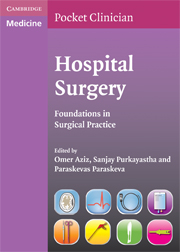Book contents
- Frontmatter
- Contents
- List of contributors
- Foreword by Professor Lord Ara Darzi KBE
- Preface
- Section 1 Perioperative care
- Consent and medico-legal considerations
- Elective surgery
- Special situations in surgery: the diabetic patient
- Special situations in surgery: the jaundiced patient
- Special situations in surgery: patients with thyroid disease
- Special situations in surgery: steroids and surgery
- Special situations in surgery: surgical considerations in the pregnant woman
- Haematological considerations: thrombosis in surgery
- Haematological considerations: bleeding
- Haematological considerations: haemorrhage (massive-bleeding protocol)
- Haematological considerations: blood products and transfusion
- Shock
- Fluid management
- Electrolyte management
- Pain control
- Nutrition
- Antibiotic prescribing in surgery
- Critical care: the critically-ill patient, decision making and judgement
- Critical care: cardiovascular physiology and support
- Critical care: respiratory pathophysiology and support
- Critical care: renal support
- Critical care: other considerations
- Postoperative complications
- Surgical drains
- Abdominal stoma care
- Section 2 Surgical emergencies
- Section 3 Surgical disease
- Section 4 Surgical oncology
- Section 5 Practical procedures, investigations and operations
- Section 6 Radiology
- Section 7 Clinical examination
- Appendices
- Index
Critical care: renal support
Published online by Cambridge University Press: 06 July 2010
- Frontmatter
- Contents
- List of contributors
- Foreword by Professor Lord Ara Darzi KBE
- Preface
- Section 1 Perioperative care
- Consent and medico-legal considerations
- Elective surgery
- Special situations in surgery: the diabetic patient
- Special situations in surgery: the jaundiced patient
- Special situations in surgery: patients with thyroid disease
- Special situations in surgery: steroids and surgery
- Special situations in surgery: surgical considerations in the pregnant woman
- Haematological considerations: thrombosis in surgery
- Haematological considerations: bleeding
- Haematological considerations: haemorrhage (massive-bleeding protocol)
- Haematological considerations: blood products and transfusion
- Shock
- Fluid management
- Electrolyte management
- Pain control
- Nutrition
- Antibiotic prescribing in surgery
- Critical care: the critically-ill patient, decision making and judgement
- Critical care: cardiovascular physiology and support
- Critical care: respiratory pathophysiology and support
- Critical care: renal support
- Critical care: other considerations
- Postoperative complications
- Surgical drains
- Abdominal stoma care
- Section 2 Surgical emergencies
- Section 3 Surgical disease
- Section 4 Surgical oncology
- Section 5 Practical procedures, investigations and operations
- Section 6 Radiology
- Section 7 Clinical examination
- Appendices
- Index
Summary
Renal dysfunction
Renal failure is a frequent problem in surgical wards and in the ICU. By far the commonest cause is acute tubular necrosis (ATN) resulting from inadequate renal perfusion, which in turn is usually due to a combination of:
▪ Hypovolaemia
▪ Hypotension
▪ Sepsis
▪ Nephrotoxic drugs
▪ Pre-existing renal disease.
In the case of sepsis, renal failure may occur as part of the syndrome of multiple organ dysfunction, when it carries a grim prognosis. However if the patient survives the acute illness, renal function usually recovers.
Oliguria
The initial manifestation of renal dysfunction is oliguria. Urine output of less than 0.5 ml/kg/hr must be corrected. If any underlying renal hypoperfusion can be corrected at an early stage, it may be possible to prevent the development of acute tubular necrosis. Management of oliguria should therefore be to:
▪ Correct hypovolaemia, if necessary using CVP guidance as described above.
▪ Correct hypotension and low cardiac output, using vasopressors or inotropes.
In previously hypertensive patients it may be necessary to raise the blood pressure to levels close to their normal pressure (which may be higher than the usual target mean arterial pressure in ICU of around 70 mmHg). Only then can the kidneys autoregulate their blood flow, allowing renal perfusion to occur.
Use of other protective strategies is not founded on evidence of clinical benefit. In particular, low-dose ‘renal’ dopamine has recently been shown to be ineffective in the critically ill.
- Type
- Chapter
- Information
- Hospital SurgeryFoundations in Surgical Practice, pp. 121 - 125Publisher: Cambridge University PressPrint publication year: 2009

